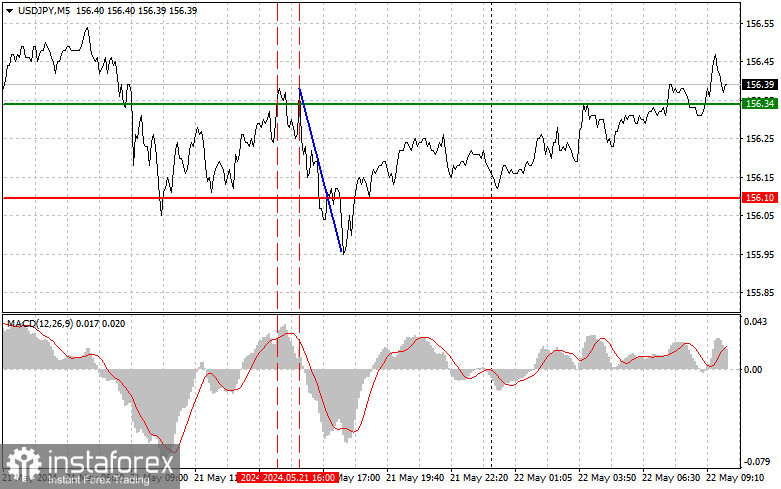Analysis of transactions and tips on trading the Japanese yen
The first test of the price of 156.34 came when the MACD indicator went up a lot from zero, limiting the pair's upward potential. For this reason, I did not buy. After a short period of time, the second test of this level occurred when the MACD was in the overbought area, which allowed scenario No. 2 to be realized for sale and resulted in a drop of the pair by more than 40 points. Today, good figures have already been released on the change in the volume of orders for machinery and equipment in Japan and the balance of foreign trade. However, all this did not stop the development of an upward trend in the dollar, which continues to be in high demand paired with the yen. It is unlikely that in the current situation, we can expect the intervention of the Central Bank of Japan, so it is better to trade according to the trend. As for the intraday strategy, I will rely more on implementing scenarios No. 1 and No. 2.

Buy signal
Scenario No. 1: I plan to buy USD/JPY today when I reach the entry point in the area of 156.56 (green line on the chart) to grow to the level of 156.91 (thicker green line on the chart). In the area of 156.91, I will exit purchases and open sales in the opposite direction (counting on a movement of 30-35 points in the opposite direction from the level). Today, the pair's growth can be counted on as part of continuing the trend. Important! Before buying, ensure the MACD indicator is above the zero mark and is just starting to grow from it.
Scenario No. 2: I also plan to buy USD/JPY today in the case of two consecutive price tests of 156.28, when the MACD indicator will be in the oversold area. This will limit the pair's downward potential and lead to an upward reversal of the market. We can expect an increase to the opposite levels of 156.56 and 156.91.
Sell signal
Scenario No. 1: I plan to sell USD/JPY today only after updating the level of 156.28 (the red line on the chart), leading to a rapid decline in the pair. The key target of sellers will be the level of 155.97, where I'm going to exit sales and immediately open purchases in the opposite direction (counting on a movement of 20-25 points in the opposite direction from the level). The pressure on the pair may return in case of an unsuccessful consolidation in the area of the daily maximum. Important! Before selling, ensure that the MACD indicator is below the zero mark and is just beginning its decline.
Scenario No. 2: I also plan to sell USD/JPY today for two consecutive price tests of 156.56, when the MACD indicator will be in the overbought area. This will limit the upward potential of the pair and lead to a downward reversal of the market. We can expect a decline to the opposite levels of 156.28 and 155.97.
What's on the chart:
The thin green line is the entry price at which you can buy a trading instrument;
The thick green line is the estimated price where you can place Take Profit or fix profit yourself, since further growth is unlikely above this level;
The thin red line is the entry price at which a trading instrument can be sold;
The thick red line is the estimated price where you can place Take Profit or fix profit yourself, since further decline is unlikely below this level;
The MACD indicator. When entering the market, it is important to be guided by overbought and oversold zones.
Important. Novice Forex traders need to make decisions about entering the market very carefully. Before the release of important fundamental reports, it is best to stay out of the market to avoid sharp fluctuations in the exchange rate. If you decide to trade during the news release, always place stop orders to minimize losses. Without placing stop orders, you can lose the entire deposit very quickly, especially if you do not use money management but trade in large volumes.
Remember that a clear trading plan, following the example I presented above, is necessary for successful trading. Spontaneous trading decision-making based on the current market situation is an inherently losing strategy for an intraday trader.
 English
English 
 Русский
Русский Bahasa Indonesia
Bahasa Indonesia Bahasa Malay
Bahasa Malay ไทย
ไทย Español
Español Deutsch
Deutsch Български
Български Français
Français Tiếng Việt
Tiếng Việt 中文
中文 বাংলা
বাংলা हिन्दी
हिन्दी Čeština
Čeština Українська
Українська Română
Română

